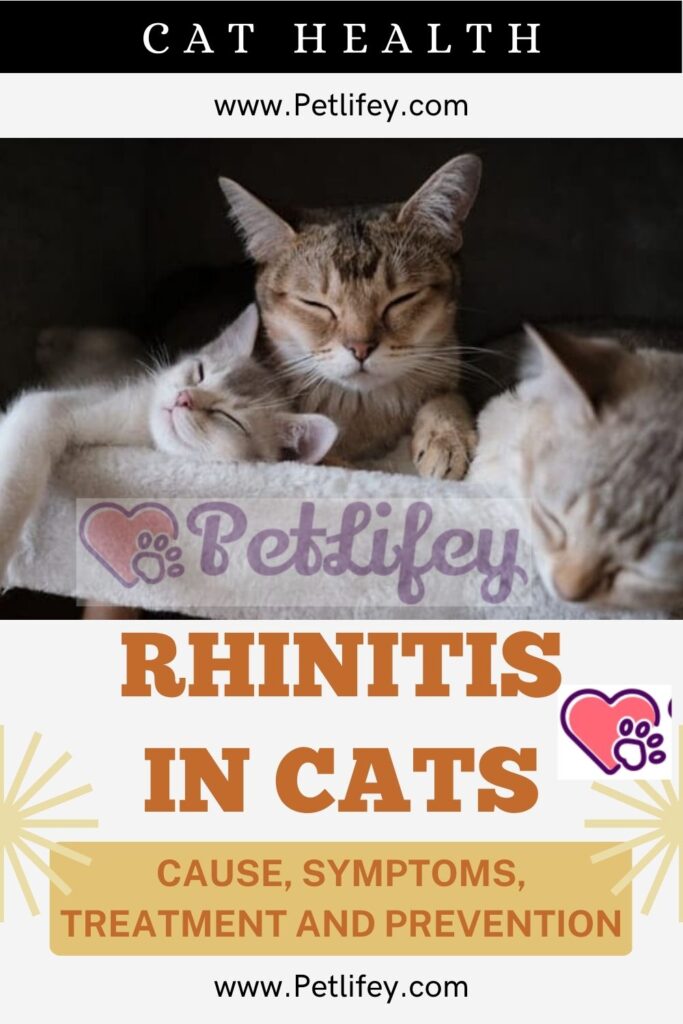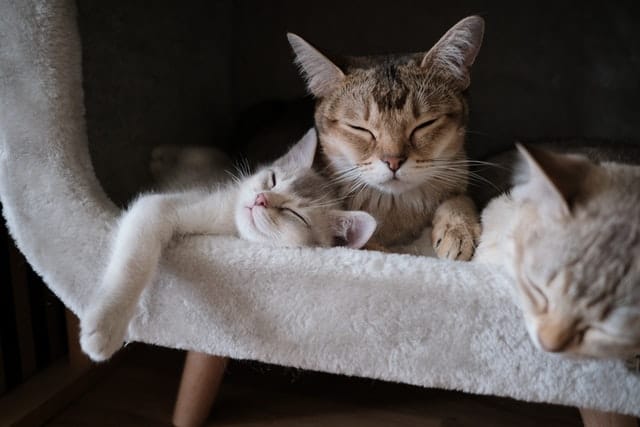
The cat has an excellent sense of smell and its sensitive nose reacts strongly to external factors and more. Let’s see what triggers rhinitis in cats and what are the symptoms.
The nasal passages in cats are very narrow and even small external stimuli can cause severe nasal congestion and a runny nose in the cat. Cat rhinitis can be caused by multiple factors: infection, mechanical or chemical effects on the nasal mucosa, allergies, respiratory diseases in cats and other causes.
One of the most frequent causes of rhinitis in cats is hypothermia, due to exposure to cold or a draft of air that leads to a cat cold. The feline is particularly sensitive to these conditions and moreover animals with reduced immunity can even catch a cold by drinking water or very cold food.
We realize that the cat has a cold when: he sneezes, has an obsessive cat cough and nasal secretions can join the eye secretions.
Symptoms of rhinitis in cats
The appearance of the first signs of rhinitis is a good reason that must push you to go to the vet. The main symptoms of rhinitis in cats are: obstruction of nasal breathing, redness of the nasal mucosa and a runny cat’s nose.
The cat is often forced to breathe only through the mouth, as rhinitis makes it difficult to breathe through the nose. When rhinitis is present, the cat often exhibits tearing and inflammation of the cat’s eyes.
Nasal discharge may be clear, liquid or thick, purulent, greenish, or yellowish, sometimes with blood loss. Purulent discharge, i.e. in the presence of pus, always indicates an infection.
Rhinitis can be accompanied by fever, general weakness and lethargy, loss of appetite with a total refusal of food, and even aggressive feline behaviors. In the event of inflammation, the lymph nodes located under the lower jaw tend to enlarge.
Rhinitis, with purulent discharge, can be a manifestation of a more serious and more dangerous infectious disease, such as panleukopenia. In this case, intervening late can lead to the death of the animal.
Causes
The cause of rhinitis in cats is often a viral, bacterial or fungal infection. In this case, the runny nose can be very clear (with a viral infection) or purulent with a greenish tinge (with a bacterial infection).
The disease is usually accompanied by fever, lethargy, diarrhea, or vomiting of the cat. Among the viral diseases for which rhinitis is generated, there are many even fatal ones: feline flu, calicivirus, panleukopenia and infectious rhinotracheitis.
Any infectious rhinitis in a cat requires mandatory treatment, which must be prescribed by a veterinarian. Bacterial infections can also have sad consequences.
Cat rhinitis can be allergic in nature, when the cat comes into contact with an allergen, such as pollen from some plants, the animal develops a redness of the nasal mucous membranes and swelling of the nasal passages, accompanied by difficulty in breathing and severe itching.
Nasal discharge can occur as a result of inhalation of paint fumes, solvents, acids and bases, smoke, various household or cosmetic chemicals. These substances cause severe irritation of the upper respiratory tract.
Such irritation can also be favored by very hot or very cold air. The result of a slight exposure to the chemical can be limited to a watery and nasal discharge if no action is taken within a short time to adequately ventilate the room to remove what is irritating.
In severe cases, if the nasal mucosa is damaged as a result of exposure to chemicals, veterinary assistance is required. In addition, the presence of a foreign body, for example if the cat inspires a grain of sand or small debris in the nostril, can also cause rhinitis in the cat even considerable secretions.
But where there should be significant severe irritation, it is best to take the cat to the doctor. Finally, nasal discharge can be a sign of cat neoplasm in the nasal passage. In this case, the help of a specialist is also needed.
Treatment of rhinitis in cats

Treatment of rhinitis in cats depends on the reasons that caused it. In case of a cold caused by a foreign body entering the nose or if the cat inhales irritants, special treatment may not be necessary, just remove the source of irritation.
While infectious diseases, accompanied by manifestations of rhinitis, must be treated. Drug treatment can only be prescribed by a doctor.
Depending on the infectious agent, the cat is prescribed antiviral, antibacterial or antifungal drugs. In case of severe nasal congestion and significant loss, vasoconstrictor nasal drops may be prescribed.
Nose streams or drying scabs from the outside should be removed with gauze or cotton swab dipped in hot boiled water. If necessary, the doctor may prescribe nasal washes with saline, boric acid solution, soda or other drugs.
Keep in mind that a sick cat should always be hydrated and his food and drink should be warm. It is necessary to provide the animal with warmth and peace. A heating mat or a heating pad, to restore warmth to the animal.
By prescription, you can warm the nose with a bag of salt or sand, but warming procedures can only be done if the cat’s temperature is warmer.
Prevention
Proper feeding of the cat and the use of vitamin supplements will help increase the cat’s resistance to infectious diseases and strengthen the immune system. It is advisable to give vitamins to the animal after consulting a veterinarian to select the optimal dose and avoid contraindications.
To prevent the consequence of allergic rhinitis, it is necessary to limit the cat’s access to possible allergens, to minimize the use of cosmetics for grooming, not to feed food other than its own, to stop using irritating household chemicals that come into contact with the cat.
You may need to get rid of some house plants or eliminate cat food products that can trigger an allergy in your pet.
Avoid letting the cat expose itself to drafts. If the cat goes out, it is necessary to limit its communication with other cats as much as possible and to exclude contact with stray animals, birds and other potential sources of infection.
To protect the cat, starting at an early age, from dangerous diseases, so it is necessary to vaccinate the cat regularly. For a cat, as for any living being, cleaning the house is important. Constant cleaning will help prevent the spread of infections.






